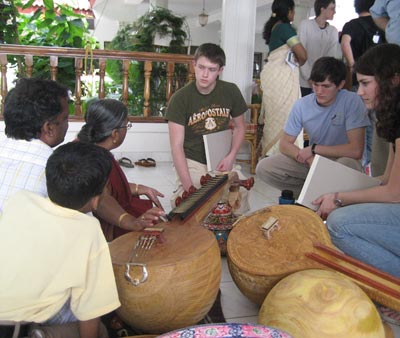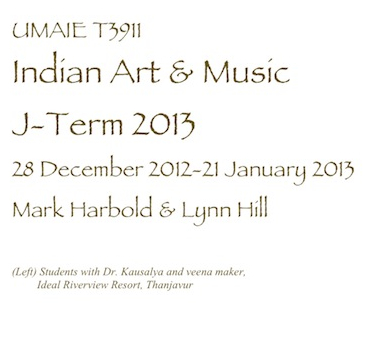

 |
 |
Indian Art & Music Syllabus | ||
|
|
|
|
|
|
|
|
| Download a printer-friendly version of the syllabus | ||
|
Some Typical Course Activities Shopping in Tambaram, with Dr. Kausalya & students in Thanjavur, working with a rug weaver in Jaipur | ||
|
COURSE DESCRIPTION |
|
Indian Art and Music is an interdisciplinary study of India’s art, architecture, and music in their religious, classical, folk, and popular contexts. Madras Christian College, our host in Chennai, provides lectures and “hands-on” sessions with renowned Indian scholars, artists, and musicians. Topics include Indian music, art, architecture, dance, religion, history, and society, and we will make music, practice traditional art forms, learn yoga, attend a Bollywood movie, and enjoy India’s vegetarian-friendly cuisine. We will go to concerts and festivals featuring India’s finest musicians, witnessing Chennai’s famed “December Season” concerts and visiting Tyagaraja sites in Tiruvaiyaru, home of the famous festival in his honor. Other trips take us to spectacular temple complexes in Thanjavur and Madurai, museums filled with iconic Chola bronze statues, a traditional bronze sculpture workshop, Mahabalipuram’s Dance Festival, a beach resort, an artists’ colony, and historic churches, temples, and mosques, ancient and modern. Service-learning opportunities include a rural village visit and work with a foundation that teaches music to poor children in Tiruvaiyaru. In Aurangabad we will see Hindu, Jain, and Buddhist art at the spectacular Ajanta and Ellora cave temples. In Delhi we study north Indian art and music and Indian history from their ancient roots to the contemporary moment. We will visit the National Museum, the National Gallery of Modern Art, India’s oldest mosque, India Gate, Mughalai restaurants, a concert, and the Gandhi Smriti Museum (site of Gandhi’s assassination), with a trip to the Taj Mahal as a special highlight. These activities offer rich, profound experiences of India’s art and music and the contexts in which they grew and still flourish. This is also a third-world immersion experience that seeks to provide an authentic Indian experience. Student accommodations will be safe but often simple. We cannot always guarantee access to hot showers, western style toilets, or toilet paper. |
|
Classes at Madras Christian College—Chennai Students with Ghatam Karthick & percussionists, our yoga master, Mark Harbold thanks Dr. Sunder & musicians | ||
|
COURSE GOALS |
|
This course will help you to:
|
|
Course Activities at Madras Christian College—Chennai Morning journaling on guest house porch, bull horns painted for Pongal, dessert!—Dr. Kingsley chops sugarcane | ||
|
REQUIRED READINGS |
|
PRIMARY TEXTBOOKS
|
|
SUPPLEMENTAL READINGS
|
|
SUPPLEMENTAL READING LIST INDIAN ART & ARCHITECTURE
|
|
At the Beach Resort—Mahabalipuram (Mamallapuram) Watching the waves on the Bay of Bengal, Ideal Resort welcome ritual, group hike to Tiger Cave | ||
|
COURSE EVALUATION |
|
Grades will be assigned based on the following:
|
|
On the Road to Historic Sites At the Thanjavur train station, in hushed awe at site of Gandhi assassination, at City Palace in Jaipur | ||
| Page created 2 April 2012 by Mark Harbold—last updated 16 October 2012. |